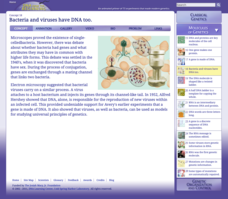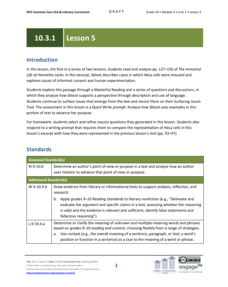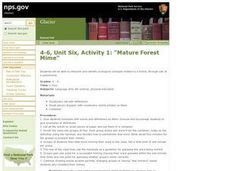National Nanotechnology Infrastructure Network
Help or Hype: The Ethics of Bio-Nanotechnology
Ethical concerns are not always black and white. A well-designed lesson plan presents learners with scenarios for which ethics may come into question. Scholars learn to consider the different sides of a situation and make an unbiased...
Curated OER
Sinking Races
Students build plankton models and compete to see which sinks most slowly. They write, or orally present ,the adaptations they incorporated to slow the sinking rate of their organisms. Race results can be grounds for some prizes!
Curated OER
Anatomy of a Bone - Coloring
Clarify and color code the anatomy of a bone with this resource. This worksheet lists 7 parts of a bone along with a definition for each part. Learners read through this information and color in each part of the bone a listed color. They...
Curated OER
Bacterial Transformation - Biology Teaching Thesis
Students explain the following processes: bacteria transformation, genetic recombination, and antibacterial breakdown of bacteria. They follow lab protocol and use the scientific method: to make predications, and to explain an unexpected...
Curated OER
What is Biotechnology?
Young consumers explore the concept of biotechnology as it pertains to the foods they eat, economics, and agriculture. They watch several videos, explore a website, complete worksheets, and engage in class discussion. Son they'll know...
Cornell University
Electroplating
Silver pennies and copper nickels are made possible by applying some chemistry. Learners use electrolysis to coat a penny with zinc sulfate and a nickel with copper sulfate. Their investigation builds an understanding of electroplating...
Cold Spring Harbor Laboratory
Bacteria and Viruses Have DNA Too
In the 1940s, scientists discovered bacteria conjugation, the process of DNA transfer or bacterial sex. The discovery proved that bacteria and viruses contain DNA and led to a Nobel prize. Interested individuals learn about the...
EngageNY
Grade 10 ELA Module 3: Unit 1, Lesson 5
Science over humanity? Scholars analyze an excerpt from The Immortal Life of Henrietta Lacks. They must consider if the experimentation of Henrietta's cells without her consent was worth the information gained about cancer. They discuss...
Curated OER
Kingdom Animalia ~ A Look at the Five Major Classes
Biological taxonomy masters examine the five main classes under phylum chordata. Pupils compare and contrast the identifying characteristics of the various organisms. They explain why taxonomy is important in classifying organisms. You...
Curated OER
Alcohol and Pregnancy Don't Mix!
Seventh graders learn about John Kellerman, a youngster who was born with Fetal Alcohol Syndrome. They learn how alcohol and pregnancy doesn't mix.
Curated OER
Coffee & Chocolate: Knowing Healthy Foods
An article relaying vital information about health and nutrition are the backbone of this lesson plan on eating the right foods. A series of activities are used to help upper graders understand the science supporting our understanding of...
Curated OER
Mature Forest Mime
Young scholars come to understand vocabulary words through pantomime. In this vocabulary lesson plan, students first review several vocabulary words and their meaning, then they work in groups to pantomime the definitions.
Curated OER
Cellular Respiration and Photosynthesis
In this cellular respiration and photosynthesis worksheet, students read through the presented material and draw an illustration of the production of ATP. Students answer several short answer questions about the production of ATP,...
Curated OER
Dolphins
Students investigate dolphins. They complete a Webquest, explore various websites, listen to audio clips of dolphin sounds, play an online puzzle game, answer discussion questions, and read and evaluate newspaper articles about...
Curated OER
Characteristics of Living Things
Seventh graders identify the characteristics of living and non-living things. In this biology lesson, 7th graders define vocabulary words as they go through the lesson. They answer a crossword puzzle after class discussion.
Curated OER
Sponges, Cnidarians, Flatworms, and Roundworms
In this simple animals worksheet, students read information about sponges, cnidarians, flatworms, and roundworms and then complete a chart comparing and contrasting these groups of animals. This worksheet has 11 fill in the blank questions.
Curated OER
Bacteria: Friend or Foe?
Young scholars examine a variety of environmental and industrial roles of bacteria. explore where bacteria can be found and distinguish bacteria from other organisms.
Curated OER
The Deep
In this deep ocean learning exercise, students answer twenty questions after watching a video about the species that live in the deep ocean. Topics include jelly fish, hatchet fish, anglers, tubeworms, sea urchins, and plants that grow...
Curated OER
Introduction to Adult Insects and Their Adaptations
Students study organisms found in Class Insecta. They examine the different adaptations these organisms have developed over time to survive and prosper in their respective habitats. They research the origin of the names of several orders...
Curated OER
From DNA to Protein
In this DNA worksheet, students will compare the chemical differences between DNA and RNA. Students will review what makes up the genetic code and the steps of transcription from DNA to mRNA to proteins. This worksheet has 26 fill in the...
Curated OER
Cnidarians Crossword Puzzle
For this crossword puzzle about Cnidarians worksheet, 6th graders write examples, words being defined, parts of the Cnidarians, and kinds of Cnidarians to complete the crossword puzzle review. Students write seventeen answers..
Curated OER
Living by the Code
Young scholars explain why new drugs are needed to treat cardiovascular disease, cancer, inflammation, and infections. They infer why some marine invertebrates are promising sources of new drugs, explaining the process in which cells...
Curated OER
H2O in Us
Young scholars discover through this activity that all organisms are composed of water. They find that 70 percent of their bodies are made up of water that is in thier cells and blood, and not free-flowing throughout their body.
Curated OER
Who Stole My Salad?
Eighth graders explain how protein is made in the cell. In this biology lesson, 8th graders translate RNA and DNA using an internet database. They determine the thief based on evidence collected.

























